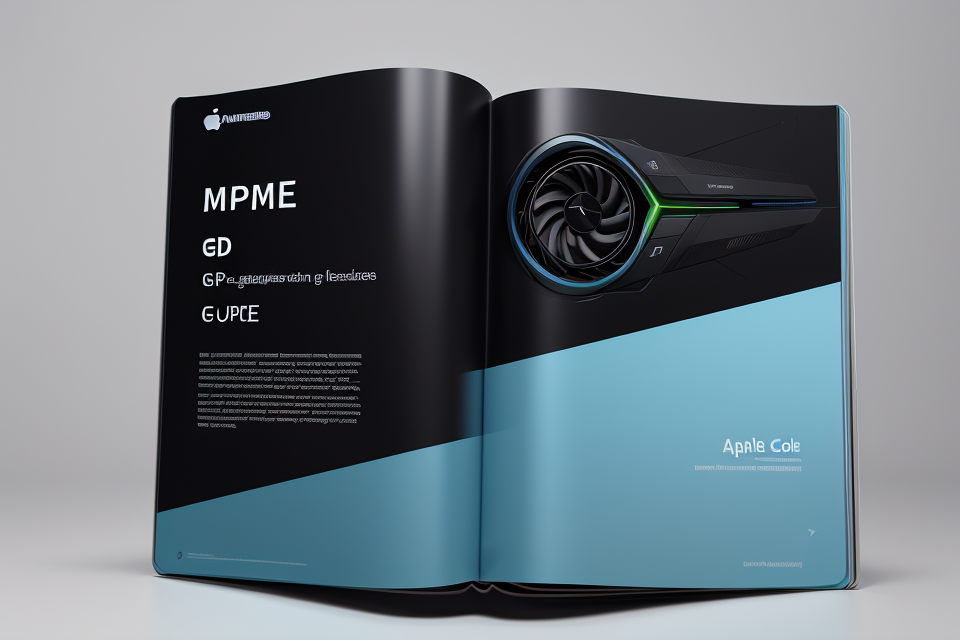
GPUs or Graphics Processing Units are a critical component of modern computing, playing a vital role in gaming, video editing, and other graphics-intensive applications. However, with so many options available in the market, determining the quality of a GPU can be a daunting task. Is it the brand? The price? The number of cores? Or something else entirely? In this article, we will delve into the complexities of GPUs and explore what truly determines their quality. So, buckle up and get ready to unpack the secrets behind the performance of GPUs.
Factors Affecting GPU Performance: A Comprehensive Overview
Graphics Processing Unit (GPU) Architecture
Introduction to GPU Architecture
The Graphics Processing Unit (GPU) architecture refers to the layout and design of the components that make up a GPU. It is responsible for rendering images, animations, and video on various devices such as computers, smartphones, and gaming consoles. The architecture of a GPU is crucial in determining its performance and efficiency in handling complex tasks.
Key Components of GPU Architecture
The following are the key components of a GPU architecture:
- Shader Units: These are small processing cores that execute the shader programs, which are responsible for rendering graphics on the screen. The number of shader units in a GPU affects its performance.
- Render Output Units (ROU): These units are responsible for writing the output of the shader units to the frame buffer. The number of ROU in a GPU determines its throughput.
- Memory Hierarchy: This includes various levels of memory caches and main memory. The memory hierarchy is critical for the efficient fetching and processing of data by the GPU.
- Interconnect Network: This network connects the different components of the GPU and enables data to be transmitted between them. The efficiency of the interconnect network affects the overall performance of the GPU.
- APIs (Application Programming Interfaces): These are the software interfaces that allow applications to communicate with the GPU. The availability of APIs for specific tasks affects the versatility of the GPU.
Factors Affecting GPU Architecture
The following factors influence the design and performance of a GPU architecture:
- Manufacturing Process: The process used to manufacture the GPU, such as 7nm or 14nm, affects its performance and power efficiency.
- Compute Units: The number and design of the compute units in a GPU determine its processing power.
- Memory Bandwidth: The speed at which the GPU can access its memory affects its performance.
- Power Delivery: The efficiency of the power delivery system affects the performance and cooling requirements of the GPU.
- Price and Profitability: The cost of producing a GPU and the target market price also influence its design and features.
In conclusion, the GPU architecture is a critical factor in determining its performance. It includes key components such as shader units, render output units, memory hierarchy, interconnect network, and APIs. Factors such as manufacturing process, compute units, memory bandwidth, power delivery, and price also influence the design and performance of a GPU architecture.
Memory
When it comes to determining the quality of a GPU, memory plays a crucial role. In the world of graphics processing units, memory refers to the space available on the GPU for storing data during the execution of graphical tasks. This memory is specifically designed to handle the immense amount of data that is processed by the GPU.
Type
The type of memory used in a GPU can have a significant impact on its performance. There are two main types of memory used in GPUs: GDDR (Graphics Double Data Rate) and SGRAM (Synchronous Graphics Random Access Memory). GDDR is the most commonly used type of memory in modern GPUs due to its higher bandwidth and lower power consumption. GDDR memory is also known for its ability to handle large amounts of data, making it ideal for tasks such as video rendering and gaming.
Amount
The amount of memory available on a GPU is another important factor in determining its quality. In general, the more memory a GPU has, the better it is at handling complex graphics tasks. However, it is important to note that adding more memory to a GPU is not always the best solution, as it can also increase power consumption and heat output. Therefore, finding the right balance between memory capacity and power efficiency is crucial for optimizing GPU performance.
Bandwidth
Bandwidth refers to the speed at which data can be transferred between the GPU memory and the rest of the system. A higher bandwidth means that data can be transferred more quickly, resulting in faster performance. When considering the quality of a GPU, it is important to pay attention to the memory bandwidth, as it can have a significant impact on overall performance. In general, higher bandwidth memory will result in smoother and more efficient graphics rendering.
Power Efficiency
Thermal Design Power (TDP)
Thermal Design Power (TDP) is a metric that defines the maximum amount of power a GPU can consume without exceeding the maximum allowable temperature during normal operation. It represents the upper limit of power that a GPU can handle without causing permanent damage to the chip. The TDP value is usually given in watts (W) and is a critical factor in determining the power efficiency of a GPU.
Power Usage Effectiveness (PUE)
Power Usage Effectiveness (PUE) is a metric that measures the efficiency of a data center’s power usage. It is defined as the ratio of the total amount of power consumed by a data center to the power actually used by the IT equipment. In other words, PUE is a measure of how much power is lost due to inefficiencies in the data center infrastructure.
A lower PUE indicates higher power efficiency, as more of the power consumed is being used to perform actual computing tasks rather than being lost due to inefficiencies. Therefore, a GPU with a lower PUE value is considered more power efficient and will have a higher quality rating.
It is important to note that while TDP and PUE are important factors in determining the power efficiency of a GPU, they are not the only factors to consider. Other factors such as the GPU’s architecture, clock speed, memory capacity, and cooling system can also affect its overall power efficiency and performance.
Understanding the Importance of CUDA Cores and Texture Units
CUDA Cores
- Role in processing power
- CUDA cores, also known as Streaming Multiprocessors (SMs), are the primary building blocks of a GPU, responsible for executing the actual mathematical operations of a program.
- The number of CUDA cores directly impacts the overall processing power of the GPU, with more cores translating to greater performance in parallel computation tasks.
- Performance impact
- The performance of a GPU is directly proportional to the number of CUDA cores it possesses.
- Increasing the number of CUDA cores in a GPU results in a linear increase in the theoretical maximum performance of the GPU, as each additional core can process more instructions per clock cycle.
- However, the actual performance gains achieved by increasing the number of CUDA cores may be limited by other factors such as memory bandwidth and thermal constraints.
Texture Units
Texture units play a crucial role in the overall performance of a GPU. These small processing units are responsible for handling texture mapping, which is the process of applying a 2D texture to a 3D model. The number of texture units a GPU has can have a significant impact on its performance, particularly in graphics-intensive applications.
In addition to their role in rendering 3D graphics, texture units also play a critical role in image processing. This includes tasks such as image filtering, which is used to smooth or sharpen images, and image compression, which reduces the size of images without sacrificing quality. The performance of these tasks is heavily dependent on the number and speed of texture units in a GPU.
Furthermore, the performance impact of texture units is not limited to graphics-intensive applications. Many general-purpose computing applications also make use of texture units for tasks such as image processing and scientific simulations. As a result, the number and speed of texture units in a GPU can have a significant impact on the overall performance of a system.
Overall, the importance of texture units in a GPU cannot be overstated. They play a critical role in both graphics rendering and image processing, and their performance can have a significant impact on the overall performance of a system.
Evaluating Clock Speeds: Frequency, Turbo, and Memory Clock
*### Clock speed and performance
When it comes to evaluating the quality of a GPU, clock speed is an essential factor to consider. Clock speed, also known as frequency, refers to the number of cycles per second that a GPU’s processor can execute. In general, a higher clock speed means that the GPU can perform more calculations per second, resulting in better performance.
However, it’s important to note that clock speed alone does not determine a GPU’s performance. The number of cores, memory bandwidth, and other factors also play a significant role in determining a GPU’s overall performance.
*### Turbo boost technology
Some GPUs come equipped with turbo boost technology, which allows the clock speed to increase temporarily under certain conditions. For example, when a game is running, the GPU’s clock speed may increase to provide a boost in performance. This can be useful for gamers who want to get the most out of their GPUs during intense gaming sessions.
It’s important to note that not all GPUs have turbo boost technology, and the effectiveness of this feature can vary depending on the specific GPU model.
*### Memory clock and bandwidth
The memory clock speed and bandwidth of a GPU are also important factors to consider when evaluating its quality. Memory clock speed refers to the frequency at which the GPU’s memory can access data, while memory bandwidth refers to the amount of data that can be transferred to and from the memory per second.
In general, a higher memory clock speed and bandwidth can result in faster data transfer rates, which can improve overall performance. However, it’s important to note that other factors, such as the type and amount of memory installed, can also affect memory performance.
GPUs for Different Uses: Gaming, Professional, and Workstations
Gaming GPUs
When it comes to gaming, the quality of a GPU is crucial for providing an immersive and seamless gaming experience. The key features that determine the quality of a gaming GPU include its performance, power efficiency, and compatibility with popular gaming platforms.
Key features for gaming
- Performance: A gaming GPU should have a high processing power to handle demanding games with high-quality graphics and smooth frame rates.
- Power efficiency: A gaming GPU should be energy-efficient to prevent overheating and reduce the need for frequent shutdowns or restarts.
- Compatibility: A gaming GPU should be compatible with popular gaming platforms, such as Windows, Mac, and Linux, and should be able to support a wide range of games.
Popular models and brands
Some of the most popular gaming GPU brands include NVIDIA and AMD. These brands offer a range of models with varying performance levels, from entry-level to high-end. For example, NVIDIA’s GeForce GTX series and AMD’s Radeon RX series are popular choices for gaming enthusiasts.
In addition to these brands, other manufacturers such as ASUS, MSI, and Gigabyte also offer high-quality gaming GPUs with advanced features and customizable settings. When choosing a gaming GPU, it is important to consider the specific needs of your gaming setup and budget.
Professional and Workstation GPUs
Professional and workstation GPUs are designed to handle demanding tasks such as 3D rendering, video editing, and simulations. These GPUs require specific features that set them apart from gaming GPUs.
Key features for professional use
- High performance: Professional GPUs must have high processing power to handle complex tasks efficiently.
- Reliability: These GPUs need to be able to run for long periods without crashing or experiencing technical issues.
- Stability: Professional GPUs must be able to run multiple applications simultaneously without experiencing lag or crashes.
- Compatibility: These GPUs must be compatible with various software programs and operating systems.
- Expandability: Professional GPUs should have the ability to be upgraded or expanded as technology advances.
Popular models and brands
Some popular models of professional and workstation GPUs include:
- NVIDIA Quadro and AMD Radeon Pro series
- NVIDIA Tesla and AMD Radeon Instinct series
- NVIDIA GeForce RTX and AMD Radeon RX series
These brands are known for their high-performance, reliable, and stable GPUs that are specifically designed for professional and workstation use. They also offer a range of prices to suit different budgets and requirements.
Factors Influencing GPU Price: Cost-to-Performance Ratio and Generation
Cost-to-performance ratio
When it comes to purchasing a GPU, the cost-to-performance ratio is a crucial factor to consider. This ratio evaluates the price of the GPU in relation to its performance. A GPU with a higher cost-to-performance ratio may offer more advanced features and capabilities, but it may also come with a heftier price tag. Conversely, a GPU with a lower cost-to-performance ratio may be more budget-friendly, but it may not provide the same level of performance as a more expensive GPU.
The cost-to-performance ratio can vary greatly depending on the specific GPU model and its intended use. For instance, a high-end GPU designed for gaming may have a higher cost-to-performance ratio than a mid-range GPU designed for more basic tasks such as web browsing and document editing. In contrast, a low-end GPU designed for basic tasks may have a lower cost-to-performance ratio than a mid-range GPU.
When assessing the cost-to-performance ratio of a GPU, it is important to consider the specific tasks and applications for which the GPU will be used. For example, a GPU with a higher cost-to-performance ratio may be more suitable for professional applications such as video editing or 3D modeling, while a GPU with a lower cost-to-performance ratio may be more appropriate for casual gaming or basic computing tasks.
Impact of generation on price
Another factor that can influence the price of a GPU is its generation. Generations of GPUs are typically released in a sequential manner, with each new generation offering improved performance and capabilities over the previous generation. As a result, the price of a GPU tends to increase with each new generation.
The impact of generation on price can vary depending on the specific GPU model and its intended use. For instance, a high-end GPU from the latest generation may command a premium price due to its advanced features and capabilities. On the other hand, a mid-range GPU from an older generation may be more budget-friendly, but it may not offer the same level of performance as a newer model.
When considering the impact of generation on price, it is important to evaluate the specific needs and requirements of the intended use. For example, a GPU from the latest generation may offer significant performance improvements over an older model, but it may also come with a higher price tag. Conversely, an older GPU model may be more budget-friendly, but it may not provide the same level of performance as a newer model.
In conclusion, the cost-to-performance ratio and generation are two important factors that can influence the price of a GPU. By considering these factors, consumers can make informed decisions when selecting a GPU that meets their specific needs and requirements.
Additional Considerations: VR Ready, Ray Tracing, and More
- VR Ready GPUs
Virtual reality (VR) gaming is an emerging trend in the gaming industry, with the popularity of VR headsets like the Oculus Rift, HTC Vive, and PlayStation VR. These headsets require a powerful GPU to deliver smooth, lag-free VR experiences. When selecting a GPU, it’s crucial to consider its compatibility with VR headsets. Look for GPUs that meet the VR headset’s minimum requirements or exceed them for optimal performance. - Ray Tracing Capabilities
Ray tracing is a technique used to simulate light behavior in a scene, providing more realistic lighting and shadows. This feature is particularly important for graphically intensive games and applications, such as those in the architecture, engineering, and construction industries. GPUs with robust ray tracing capabilities can offer a significant performance boost over those without this feature. - Other Advanced Features
Beyond VR and ray tracing, other advanced features may influence a GPU’s quality. These may include:- Multiple Display Support: Some GPUs support multiple displays, allowing for greater flexibility in monitor setup and improved productivity.
- Power Efficiency: A GPU’s power efficiency can impact its overall performance and lifespan. GPUs with better power efficiency may run cooler and require less electricity, resulting in cost savings over time.
- Memory Size and Type: The amount and type of memory a GPU has can affect its performance in handling complex tasks and rendering images. GPUs with larger memory capacities and faster memory speeds may offer better performance in certain scenarios.
- CUDA or OpenCL Support: Some GPUs support CUDA or OpenCL, which are programming languages designed for parallel computing. This support can enable faster processing and improve the overall performance of the GPU.
FAQs
1. What is a GPU?
A GPU, or Graphics Processing Unit, is a specialized type of processor designed specifically for handling the complex calculations required for rendering images and video. GPUs are commonly used in gaming systems, but they also have applications in fields such as scientific computing, machine learning, and cryptocurrency mining.
2. What are the key factors that determine the quality of a GPU?
There are several key factors that determine the quality of a GPU, including its performance, power efficiency, memory capacity, and compatibility with other components. Other important considerations include the type and number of ports available, as well as the level of support offered by the manufacturer.
3. How do I determine the performance of a GPU?
Performance is typically measured in terms of frames per second (FPS), which represents the number of images that can be rendered in a second. This is an important metric for gamers, as it indicates how smoothly the game will run. In general, a higher FPS means a smoother gaming experience. Other performance metrics include clock speed, memory bandwidth, and the number of cores.
4. What is power efficiency?
Power efficiency refers to the amount of power a GPU uses relative to its performance. This is an important consideration for users who want to minimize their energy costs or who want to use their GPU for applications that require it to run continuously. Higher-end GPUs tend to be less power-efficient than lower-end models, but they also offer better performance.
5. What is memory capacity?
Memory capacity refers to the amount of memory available on a GPU. This is an important consideration for users who want to run applications that require a lot of memory, such as video editing or 3D modeling. Most GPUs have 4GB or 8GB of memory, but some high-end models can have up to 16GB or more.
6. What are the different types of GPUs?
There are several different types of GPUs, including integrated GPUs, which are built into the CPU, and discrete GPUs, which are standalone cards that can be installed in a computer’s PCIe slot. Discrete GPUs are generally more powerful than integrated GPUs, but they also tend to be more expensive.
7. How do I choose the right GPU for my needs?
Choosing the right GPU depends on your specific needs and budget. If you are a gamer, you will want to consider a GPU that offers high performance and a high FPS. If you are using your GPU for other applications, such as video editing or machine learning, you will want to consider a GPU that offers a high memory capacity and good power efficiency. It is also important to consider compatibility with other components in your system.


